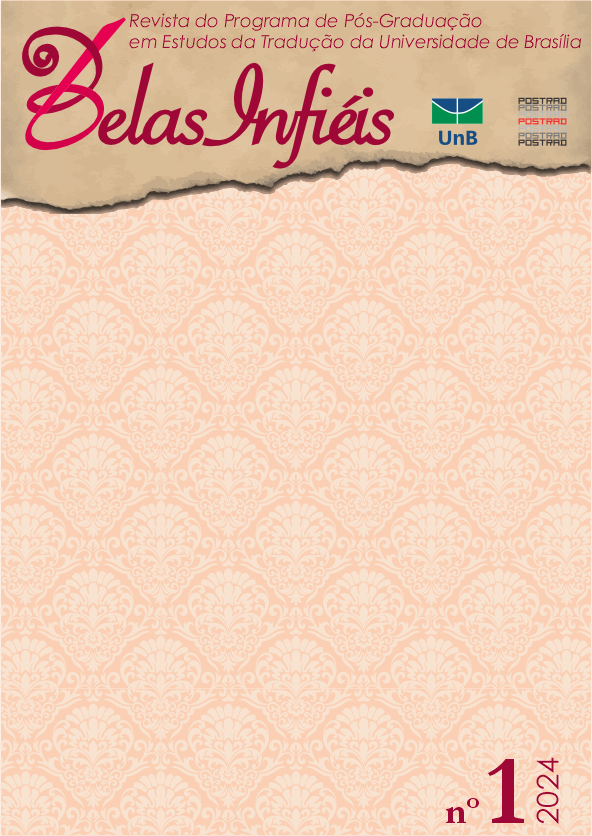User-Centered Translation and Training in Media Accessibility: A Case Study
DOI:
https://doi.org/10.26512/belasinfieis.v13.n1.2024.52287Keywords:
Media Accessibility. Accessible Audiovisual Translation. Translator Training. User-Centered Translation. Audio Description.Abstract
Over the years, the study of reception has gained more and more prominence in the field of Audiovisual Translation (AVT), especially in the case of the modalities most directly associated with media accessibility. However, this attention to the audience has not always been addressed by the models adopted for translators’ training. In this text, we present User-Centered Translation (UCT), designed by Tytti Suojanen, Kaisa Koskinen and Tiina Tuominen, as a proposal to solve this problem. To this end, we explain the UCT model and then illustrate its application through the analyses and discussion of a training experience carried out with undergraduate students from Instituto de Letras da Universidade Federal da Bahia. At the end of the experience, the students reported gains involving both scriptwriting, reviewing and editing, in addition to highlighting the work with interpersonal relationship skills and the contact with members of the target audience. These results lead us to believe that UCT allows for a critical, reflective and collaborative practice, which guarantees greater chances of success in meeting the needs and preferences of the end users. Therefore, we hope to contribute to the popularization of UCT and to raise awareness to the importance of adopting user-centered practices in the training of translators, instigating the debate about new training models in Media Accessibility (MA).
Downloads
References
Baños, R., & Díaz-Cintas, J. (2018). Language and translation in film: Dubbing and subtitling. In K. Malmkjaer (Ed.), The Routledge handbook of translation studies and linguistics (pp. 313-326). Routledge.
Di Giovanni, E., & Gambier, Y. (Eds.). (2018). Reception studies and audiovisual translation. John Benjamins Publishing Company.
Esqueda, M. D., Ferreira, G. A., & Morais, C. F. (2023). “Preparando o terreno”: Palavras introdutórias dos tradutores à tradução do texto de Don Kiraly (2012), Cultivando uma pedagogia da tradução baseada em projetos: uma perspectiva fractal. Revista Belas Infiéis, 12(1), 01-23. https://doi.org/10.26512/belasinfieis.v12.n1.2023.46755
Greco, G. M. (2018). The nature of accessibility studies. Journal of Audiovisual Translation, 1(1), 205–232.https://www.jatjournal.org/index.php/jat/article/view/51/10
Greco, G. M., & Jankowska, A. (2020). Media accessibility within and beyond audiovisual translation. In L. Bogucki, & M. Deckert (Eds..), The Palgrave handbook of audiovisual translation and media accessibility (pp. 57-81). Palgrave Macmillan.
Kiraly, D. (2000). A Social Constructivist Approach to Translator Education. St. Jerome.
Nord, C. (2012). Quo vadis, functional translatology?. Target, 24(1), 26–42. https://benjamins.com/catalog/target.24.1.03nor
Perego, E., & Pacinotti, R. (2020). Audiovisual translation through the ages. In L. Bogucki, & M. Deckert (Eds.), The Palgrave handbook of audiovisual translation and media accessibility (pp. 33-56). Palgrave Macmillan.
Reiss, K., & Vermeer, H. J. (1996). Fundamentos para una teoría funcional de la traducción (Reina, S., & De Leon, C., Trad. para espanhol). Akal.
Silva, M. C. C. C. da (2019). Para além do visível: Princípios para uma audiodescrição menos visocêntrica [Tese de doutorado, Universidade Federal da Bahia]. Repositório Institucional da UFBA. https://repositorio.ufba.br/handle/ri/29344
Silva, M. C. C. C. da, Jesus, M. N. de, Soares, E. A., & Queiroz, A. da S. (2022). Caminhos para a acessibilidade educacional: audiodescrição das imagens do aplicativo Iara. GEMInIS, 12(3), 100-123. https://doi.org/10.53450/2179-1465.RG.2021v12i3p100-123
Soares, E., & Silva, M. C. C. C. da. (2023). Novos horizontes em tradução audiovisual: Audiodescrição de imagens estáticas no aplicativo IaraApp. In L. M. T. R. Baptista, C. D.P. de Souza, A. B. H. de Góes, & I. S. Costa (Orgs.), Linguagem e interação em foco: Desafios e possibilidades no cenário contemporâneo (Vol. 2, pp. 25-39). EDUFBA.
Stake, R. E. (1999). Investigación con estudio de casos. Morata.
Suojanen, T., Koskinen, K., & Tuominen, T. (2015). User-Centered translation. Routledge.
Vercauteren, G. (2014). A translational and narratological approach to audio describing narrative characters. TTR: traduction, terminologie, rédaction, 27(2), 71-90. https://www.erudit.org/en/journals/ttr/2014-v27-n2-ttr02697/1037746ar.pdf
Yin, R. K. (1993) Applications of case study research. Sage Publishing.
Downloads
Published
How to Cite
Issue
Section
License
Copyright (c) 2024 CC BY

This work is licensed under a Creative Commons Attribution 4.0 International License.
Given the public access to this journal, the texts are free to use but requires the recognition of the original authorship and initial publication in this journal to be properly stated.
 The journal allows the use of works published for non-commercial purposes, including the right to submit the work to publicly accessible databases. Published contributions are the sole and exclusive responsibility of the author(s).Â



















